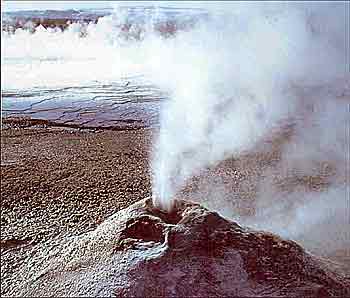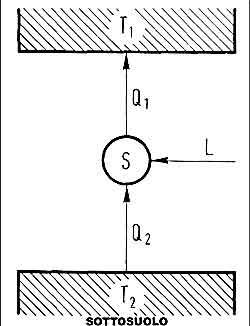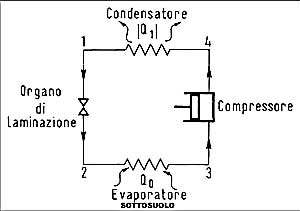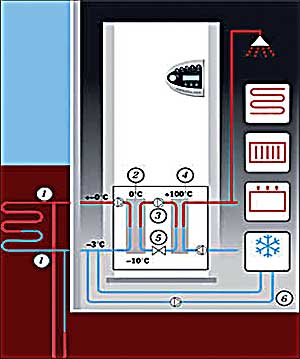The innovative domestic heating system in
Madonna di Campiglio, which exploits the bowels of the Earth.
Energy scenario:
renewable sources and geothermics
by Ivan Castellani*
 The
energetic problem is common to both great industry and the
medium or small user, such as private citizens and craftsmen. The
energetic problem is common to both great industry and the
medium or small user, such as private citizens and craftsmen.
The present European and national sceneries present at least
two main streams of consumption: thermical by combustion,
and electricity that still depends on fossil fuel such as
oil, natural gas or coal.The D.L.16 March 1999 n.79(Bersani
Law), that has liberalized the electricity market has also
established in Italy the so-called energetic market. According
to it, it is now possible, for eligible users, to buy and
sell electricity in the so-called "Power Exchange",
where competition rules apply. Eligible users are, dating
back to the year 2004, all those people who possess VAT number,
that means, every client other than domestic users. These
latter represent the bound customers, who cannot enter into
a contract of supply with any distributor, but are obliged
to stock up on those who exert the service in their own territory.
The market guarantor for those users is the so called single
buyer (AU) who ensures the continuous availbility and supply
of energy and fair prices. The AU signs buy and sell contracts
on the market. From January 2007 every final client will become
eligible, including domestic users.
Alternative sources of energy (aeolian, solar, geothermal,
tidal, hydraulic, from biomasses and biogases etc.) have become
more and more appealing. Among the measures for promoting
their use, we find the Green Certificates, introduced back
in 1999 and granted by the GRTN. They certify that a certain
amount of energy (measured in kilowatt-hour - kwh) put on
the market by a producer, comes from renewable sources. Those
certificates, whose size is 50.000 Kwh, are in every respect,
real shares listed on the energy market. The incentive lays
in the fact that it is compulsory - both for producers and
importers - to introduce on the market a share of energy produced
after renewable sources equal to 2% of the total amount of
energy produced during the previous year.
From 2004 to 2006 the compulsory share has increased yearly
of 0,35 points per cent.
Whoever produces (or imports) electric energy produced from
non-renewable sources can make up with it purchasing Green
Certificates that belong to other subjects' exceeding production.
Italy is aiming at reaching 25% of electricity consumptions
from renewable sources within 2010. The process of decentralization
of energetic policies has given much authority to Regions
and Autonomous Provinces: localization of district heating
plants, energetic certification of buildings, restraints in
heating-gas emissions and so on. Trentino is, in the national
panorama, at the very first places as far as reguards the
production of energy from alternative sources; almost all
of it comes from hydroelectric power plants.
Zooming onto domestic users, in the Province of Trento, a
case of optimization of natural resources with peculiar attention
towards environmental issues has to be highlighted: the Hotel
Garni del Sogno in Madonna di Campiglio. Since it is necessary
to heat up buildings for most of the year, due to the local
climate, the impact of the use of non-fuel sources is itself
a great bonus, also in this case, where the production has
to do with heat and not with energy.
The heating plant, realized by the engineer Schiavon and that
represents the first example in its genre in the province
of Trento, is linked to a careful thermic isolation of the
building and uses geothermal power stored underground in the
form of heat. It is a very simple concept, and it does not
need any peculiar environmental condition.
Underground, and in particular in the groundwater, heat is
stored coming from solar radiation and, what is more important,
is that this tank, at certain depths, keeps a temperature
that is constant all year around.
It is all about transfering that heat, properly amplified,
offered for free by nature, to the inside of the building,
through a heat pump. What is a heat pump anyway? 
Each one of us is familiar with a fridge: it withdraws heat
from a cold environment (called the "cold source"),
that is its inner part, in order to hand over heat to a warmer
environment ("hot source"), i.e. the more external
one. Underground temperature is lower than the external one,
while the temperature inside of the building is higher.
Since the transfer of the heat from a cold area to a warmer
one cannot take place spontaneously, an external help is needed,
and it is represented by electric energy that makes a proper
engine (compressor), conceived for the purpose, work.
The heat pump works exactly like a fridge, the only difference
is its final purpose: no more withdrawing heat from a cold
environment to make it cooler and cooler, but giving heat
to a warm environment (sanitary water and domestic heating
for example). The "cold" source is the underground,
with groundwater temperature at around 10°C constant;
since it flows, the area is subject to a continuous exchange
of water with the same incoming temperature (thermic capacity
potentially unlimited), while the hot source is the water
that circulates in the heating plant.
The bigger output and, thus the bigger convenience, is reached
when the spring temperatures (T1 and T2) are close.
The installation plant is expensive as an initial investment,
compared to a classical plant (a pump of 25 Kw costs around
20.000 euros), but it should pay off in 7-8 years, following
the trend of the increasing price of fuel, that should make
the consumption of electricity more convenient than the direct
use of fuel (combustible). The optimum heating system for
this kind of plant is floor heating that needs just a temperature
of 37-38°C and that lays therefore in the range of the
highest output of the pump, while the traditional one, i.e.
panel heating system, needs a temperature of 60-80°C.
Moreover, in the last years the output of the pump has gone
from 1:2 (from 2 to 4 degrees), to around 1:4.
During the summer, pumps may also be used the other way around,
so that they give heat to the underground and cool down the
environment.
Since it is a thermodynamic type of heating, lacking totally
of fuel combustions, we avoid heat and polluting emissions
in the atmosphere, and also the installations of tanks, a
possible cause of leaks in the ground. There is, of course,
consumption of electric energy, but on a local level, the
environmental impact is equal to zero.


A
quantity of heat Q2 is extracted from the subsoil at temperature
T2. Electrical energy, represented by L, is used to transfer
it to the area to be heated at temperature T1, in the
form of Q1, which also encompasses the heat into which
L is transformed and is therefore greater than Q2.
In
the case in question, 14 shafts were dug, reaching a depth
of 105 m. The shafts were fitted with pipes leading to a collector
connected to the heat pump. Water mixed with antifreeze (glycol)
circulates in the pipes. The temperature remains constant
at 105 m below ground, at 7-10°C, even in the winter.
Upon reaching the subsoil, the water temperature reaches around
10°C. It then rises and transfers heat, via a heat exchanger,
to the pump refrigerant, which evaporates into the evaporator.
The refrigerant is then compressed by an electric motor. It
heats up and is sent to the condenser, where it transfers
its heat to the heating system water or hot water by condensing.
It then expands and cools down in the throttle valve, partially
evaporating. The hot water (4000 litres) and heating system
water (4000 litres) is heated by two pumps that absorb 25
KW and 17 KW upon start-up.
*Ivan Castellani
Environmental engineer - PhD in Energetics
|
